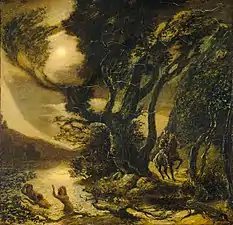Tonalism
Tonalism was an artistic style that emerged in the 1880s when American artists began to paint landscape forms with an overall tone of colored atmosphere or mist. Between 1880 and 1915, dark, neutral hues such as gray, brown or blue, often dominated compositions by artists associated with the style. During the late 1890s, American art critics began to use the term "tonal" to describe these works. Two of the leading associated painters were George Inness and James McNeill Whistler.

Tonalism is sometimes used to describe American landscapes derived from the French Barbizon style,[1] which emphasized mood and shadow. Tonalism was eventually eclipsed by Impressionism and European modernism.
Australian Tonalism emerged as an art movement in Melbourne during the 1910s.
Associated artists
- Willis Seaver Adams
- Joseph Allworthy
- Edward Mitchell Bannister
- Clarice Beckett
- Ralph Albert Blakelock
- Emanuele Cavalli
- Jean-Charles Cazin
- Colin Colahan
- Paul Cornoyer
- Bruce Crane
- Leon Dabo
- Elliott Daingerfield
- Angel De Cora
- Charles Melville Dewey
- Thomas Dewing
- Charles Warren Eaton
- Henry Farrer
- Percy Gray
- L. Birge Harrison
- Arthur Hoeber
- George Inness
- William Keith
- Percy Leason
- Xavier Martinez
- Arthur Frank Mathews
- Max Meldrum
- Robert Crannell Minor
- John Francis Murphy
- Frank Nuderscher
- Fausto Pirandello
- Henry Ward Ranger
- Granville Redmond
- Albert Pinkham Ryder
- Edward Steichen
- Dwight William Tryon
- John Twachtman
- Clark Greenwood Voorhees
- James McNeill Whistler
- Alexander Helwig Wyant
- Raymond Dabb Yelland
Gallery
 Albert Pinkham Ryder, Siegfried and the Rhine Maidens (1888 - 1891), National Gallery of Art, Washington, DC
Albert Pinkham Ryder, Siegfried and the Rhine Maidens (1888 - 1891), National Gallery of Art, Washington, DC George Inness, Summer Landscape, 1894
George Inness, Summer Landscape, 1894 John H. Twachtman, The White Bridge, c. 1895, Minneapolis Institute of Arts
John H. Twachtman, The White Bridge, c. 1895, Minneapolis Institute of Arts Leon Dabo, The Seashore, c. 1900; Oil on masonite; 76.8 x 86.4 cm
Leon Dabo, The Seashore, c. 1900; Oil on masonite; 76.8 x 86.4 cm
See also
- California Tonalism
- Australian Tonalism
Notes
- Avery, Kevin J. & Fischer, Diane P. "American Tonalism: Selections from the Metropolitan Museum of Art and the Montclair Art Museum ". Burlington Magazine, Vol. 142, No. 1168, July, 2000. p. 453.
External links
- American Paintings in The Metropolitan Museum of Art, a fully digitized 3 volume exhibition catalog
- American Tonalism - Montclair Art Museum
